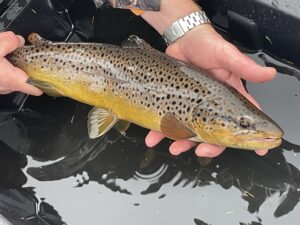Species of Interest
A core component of BRI’s mission is to assess emerging threats to wildlife and ecosystems. Our surveys are a critical tool in helping to identify and monitor threats to at-risk species and implications for human health.
 Some focal species include:
Some focal species include:
• Atlantic salmon • Landlocked Atlantic salmon
• Barracuda • Brook trout
• Brown trout • Largemouth bass
• Mahi mahi • Red Snapper
• Yellowfin tuna • Yellow perch
Contaminants Monitoring
Fish and other aquatic invertebrates are commonly used to assess contaminant exposure to both humans and wildlife among aquatic systems. Fish mercury concentrations provide important information on the potential for human exposure through their consumption from freshwater, estuarine, and marine ecosystems. This is of particular importance to vulnerable populations including children, pregnant women, and indigenous communities that rely on fish as a major protein source.
Young fish (<1 year) can reflect rapid changes of environmental mercury loads, while long-lived predatory fish, commonly consumed by humans, are of greater significance for human health. These bioindicators can also be used to assess impacts to piscivorous wildlife.
 Sampling techniques are constantly improving and BRI biologists are at the forefront of developing novel methods for nonlethal capture. For example, to determine contaminant levels in fish, BRI biologists now regularly take muscle biopsies and then release individuals back into the water. The presence of specific fish species can also be confirmed by analyzing water samples for Environmental DNA (eDNA) markers for specific fish species.
Sampling techniques are constantly improving and BRI biologists are at the forefront of developing novel methods for nonlethal capture. For example, to determine contaminant levels in fish, BRI biologists now regularly take muscle biopsies and then release individuals back into the water. The presence of specific fish species can also be confirmed by analyzing water samples for Environmental DNA (eDNA) markers for specific fish species.
As part of the Federal Energy Regulatory Commission (FERC) compliance process, BRI routinely conducts projects requiring the sampling, contaminant analyses, and assessment of fish in hydroelectric reservoirs.
Representative projects with a focus on monitoring contaminants in fish:
- FERC mercury monitoring among the Upper and Middle Dam Project, Maine (FERC #11834)
- FERC mercury monitoring among the Flagstaff Storage Project, Maine (FERC #2612)
- FERC Fifteen Mile Falls Project (FERC #2077), New Hampshire/Vermont
- Androscoggin Lake Mercury Study
Movement Studies
 BRI biologists have the expertise to design and conduct fish tagging and tracking projects using the latest tracking technology. Project objectives often involve mapping the seasonal movements of fish to identify watershed specific habitat utilization and identify the timing of spawning activity. BRI fisheries staff are adept at utilizing numerous netting or angling methods, backpack electroshocking, implanting radio transmitters, and tracking individual fish year-round.
BRI biologists have the expertise to design and conduct fish tagging and tracking projects using the latest tracking technology. Project objectives often involve mapping the seasonal movements of fish to identify watershed specific habitat utilization and identify the timing of spawning activity. BRI fisheries staff are adept at utilizing numerous netting or angling methods, backpack electroshocking, implanting radio transmitters, and tracking individual fish year-round.
Representative projects with a focus on movement studies:
• Brassua Lake/Misery Stream fish project
• Western Maine fish tracking and habitat utilization project>
International Mercury Projects
BRI has developed a Global Biotic Mercury Synthesis (GBMS) database, the first of its kind, that is a compilation and synthesis of published fish, sea turtle, bird, and marine mammal mercury data collected from around the world.
 BRI’s work with the U.S. Department of State and the United Nation’s Minamata Convention on Mercury has led to mercury monitoring projects around the world in the global effort to reduce mercury emissions and releases that harm wildlife and their environments, and which may negatively affect human health.
BRI’s work with the U.S. Department of State and the United Nation’s Minamata Convention on Mercury has led to mercury monitoring projects around the world in the global effort to reduce mercury emissions and releases that harm wildlife and their environments, and which may negatively affect human health.
In collaboration with international governments and nongovernment organizations, BRI conducts monitoring in the following regions:
- Caribbean: Antigua and Barbuda; Belize; Trinidad and Tobago
- South America: Colombia; Ecuador; Guyana; Peru; Suriname
- South Pacific: Indonesia
- West Africa: Gabon
Photo Credits: Header photo © BRI; Barracuda © Shutterstock



